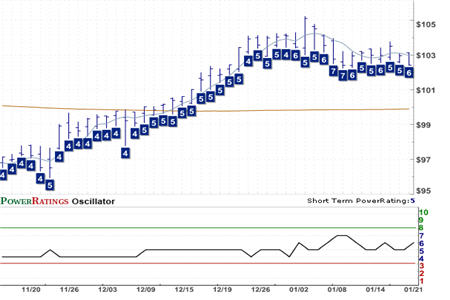PowerRatings and the Bond Market Pullback
Although stock market index futures were moving higher in the pre-market, a surprise early earnings announcement from Microsoft startled traders with news of missed earnings, major company-wide layoffs and word that the company will not provide earnings forecasts for 2009.
Unsurprisingly, traders took the opportunity to move the markets back into the red.
How long this will last is anyone’s guess. Stocks did not finish Wednesday especially overbought. But it is not difficult to imagine a trader deciding to lock in any gains from Wednesday’s strong rally, the discontents of which we see in a Dow down more than 2% less than two hours into the trading day, and a Nasdaq down more than 3%
iShares iBoxx Investment Grade Corporate Bond Fund ETF, LQD
(
LQD |
Quote |
Chart |
News |
PowerRating) Short Term PowerRating 8. RSI(2): 2.87

Where are the next opportunities? The resilience of the bond market has been the subject of much debate among traders and analysts, with some seeing in the plummeting yields evidence of a new bubble in bonds.
iShares Lehman Brothers 20 Year + Treasury Bond ETF, TLT
(
TLT |
Quote |
Chart |
News |
PowerRating) Short Term PowerRating 7. RSI(2): 3.91

We are less concerned about those larger issues and more focused on the fact that a number of bond ETFs have pulled back in recent days, creating oversold conditions that short term, mean reversion traders should perhaps pay more attention to.
iShares Lehman Brothers Aggregate Bond Fund ETF, AGG
(
AGG |
Quote |
Chart |
News |
PowerRating) Short Term PowerRating 6. RSI(2): 15.08

The Short Term PowerRatings for these bond ETFs ranges from 8 to 6, 6 representing an opportunity that is only a little better than average. And all of these bond ETFs are moving lower on Thursday, which is likely to earn at least one of these funds a Short Term PowerRating at the close if current price action continues.
Short term stock and ETF traders should keep all of these ETFs on a watch list. Although their Short Term PowerRating vary, all three have the sort of low, 2-period RSIs that we like to see in exchange-traded funds when looking for opportunities to the upside. All are oversold and the return of any buying interest could lead to significant moves in any or all of these ETFs.
According to a recent report, eight out of ten securities traded are exchange-traded funds. Want to learn how to trade them? Click here to find out what traders are saying about Larry Connors’ new book, Short Term Trading Strategies That Work: A Quantified Guide to Trading Stocks and ETFs!
David Penn is Editor in Chief at TradingMarkets.com.
